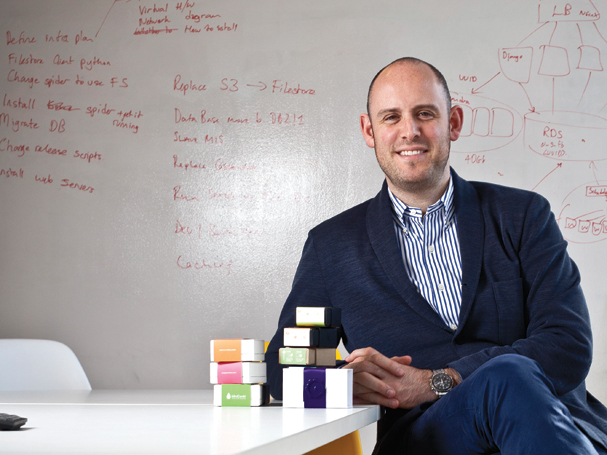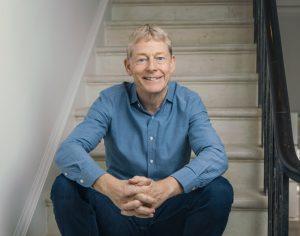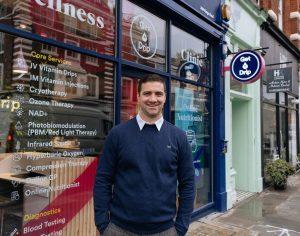For the past couple of years, ‘pivoting’ has very much been the order of the day. Just last year economist and writer Tim Harford argued the virtues of trial and error in his book Adapt: Why Success Always Starts With Failure. It is true that some businesses may be destined for failure. The product is wrong. The entrepreneur doesn’t have what it takes. The capital isn’t there. But for another business that has all the necessary ingredients, it may be one small pivot or tweak away from success.
This was very much true of moo.com, the brainchild of Richard Moross. The first iteration of his business was a bit of a flop. Customers didn’t get the concept, so they didn’t buy his products. A second launch saw customers flocking from 100 countries in the first week. So what changed? A little creative thinking and a lot of hard graft.
Moross is used to flexing his creative muscles. Born and raised in north London, the entrepreneur describes his younger self as “more creative than studious. I wasn’t an academic”. Nevertheless, he went through the motions at school, completing his GCSEs, A-levels and attended Sussex University to study philosophy and politics – a course he enjoyed, but subsequently decided wasn’t of much relevance. “Neither of those things are very useful, as it turns out.”
But his attention was diverted during his second year as there was change afoot closer to home. “My parents decided to get divorced in that first year,” he explains. “So I went from being quite happy about being away from home to being quite torn between home and college,” he continues. “Throughout my university life I went back home much more often than I probably would have done otherwise.”
Perhaps partially as a result of this, Moross didn’t do quite as well at university as he would have liked. Back in London full-time and at a loss as to what to do, Moross had a brief stint in programme finance management at the BBC, then was offered an opportunity at start-up sorted.com.
Sorted.com, set up by former television producer Andy Auerbach, was a directory of independent local businesses – from coffee houses to book stores. “It was a tool for unlocking the hidden things in your neighbourhood you didn’t know about,” recalls Moross.
The business was to be supported by advertising paid for by local companies. Unfortunately, adequate resources weren’t allocated to the ad team (consisting of Moross alone), with a focus on editorial content and the business failed in 2002. But the experience didn’t leave Moross with a bitter taste in his mouth. Far from it. “The sorted.com experience left me enthused about the internet, but unsure about what my role was going to be.”
Uncertain about which direction to take, Moross decided to follow his parents’ earlier advice to play to his creative strengths and consider advertising as a valid career avenue. He applied to 10 different graduate schemes – and was rejected from them all. “I still have all of my letters at home to remind me of my failures,” he reveals.

By his own admission, he took the rejection personally and decided that instead he would garner experience by working on projects as a freelancer.
So he gathered some friends together who were “interested in being creative and doing different things” and worked with clients on building their brands.
This entrepreneurial approach paid off. Six months later, Moross wrote to Amaze, one of the biggest independent advertising agencies in the world, and managed to secure a meeting with CEO and founder Gary Withers. “He basically hired me on the spot,” says Moross. “Gary has built an amazing business by hiring slightly weird people who don’t fit in anywhere else.”
It was during his time at Amaze that Moross first conceived of the idea for moo.com. He originally pitched the idea to Withers as an internal project – he would take a desk at the organisation and give the company a share of the business in return for investment. Despite initial interest, Amaze said no. After a bout of recent redundancies, investing in a fledgling business wouldn’t have been the most politically sensitive of manoeuvres. So Moross set out alone. “This was May 16, 2004: my first day as an entrepreneur,” he says.
As a first time business owner an introduction to shrewd investor Robin Klein was very welcome indeed. “The more I showed him of my plans, the more he seemed to be keen to be involved,” recalls Moross. A couple of months later Klein invested some seed capital into the business.
At this point, the business looked very different to the one that helped put Silicon Roundabout on the map as a centre of technical excellence and innovation.
“It was a terrible name, terrible idea,” laments Moross. “The business was called Pleasure Cards. The idea was to create a business card for your social life – to give out at a party, say, instead of in a business meeting.” This card held some information about its owner, but was in fact a key – the receiver would then have to go to the website and type in a code printed on the card to download the rest of the contact details.
At this point, Moross had only raised around £150,000, but with that money he built the product, had it manufactured (building the tooling to enable that), created the software that rendered everything, as well as all of the technology that allowed the team to take an order, then printed, packed and shipped it. “It was amazing economy, if I think about it from that perspective,” says Moross.
The site went live in early 2005 – to an unenthusiastic response from customers. “It sucked,” admits Moross. “People loved the cards, but they didn’t like what they were supposed to be doing with them. They didn’t want to have a social network attached to it; they just didn’t get that.”
As the months dragged by, business showed little sign of picking up. The company was running out of cash and its coffers weren’t being refilled as the company was only selling two or three orders a day. It was at this time that Moross met with the team at WeeWorld. The Scotland-based business made little avatars to look like its customers, who could then have the images printed on to T-shirts. “We convinced them to pay us to build a service so their customers could put them on a little card,” explains the entrepreneur.
The partnership meant a little money was in the budget for the team to hire a developer to build the integration between Pleasure Cards and WeeWorld. “It was really interesting, and brought in some money, but more importantly, we realised there was a bigger opportunity here to do this with lots of different companies,” says Moross.
With his new wingman, Steph Magdalinski, at his side, Moross flew to San Diego to attend the ETech conference. Magdalinski was already acquainted with Flickr chief software architect Cal Henderson, with whom the pair met to discuss a possible integration. By now, times were tight, so they were forced to share a hotel room. “I woke up in the morning to see Steph’s bare buttocks – that’s one of my favourite stories,” laughs Moross.

Luckily, from that moment, the day improved. Henderson agreed to the integration, meaning that Flickr’s millions of customers would now be able to upload their photographs straight to the mini cards. “Flickr was growing very quickly, and I think we felt that with a bit of help, with them marketing us, we could sell millions of these cards.”
Moross and his team started building up a pipeline of other companies with which they could build integrations, much to the interest of the investment community. A meeting with Atlas Venture was scheduled, and Moross was left feeling deflated afterwards. “I was flying to New York that afternoon, and I remember during the journey to airport I was thinking it was the most sour-faced meeting I’d ever been in with a VC,” recalls Moross.
But it seems the investors may just have had excellent poker faces: “I landed in New York and they called to say they were very interested and wanted to make us an offer.” Not that the deal was quite signed, sealed and delivered just yet. “We spoke to a few other VCs and created a little bit of healthy competition. This is very important for your own sanity and for the price, among other things.”
At the end of the process in April 2006, the business had secured investment of £2.75m with Atlas leading, and Index grabbing a slice of the action too. All investors around the table agreed on one thing – the name had to go. And with that, Pleasure Cards bit the dust and moo.com was born. The transformation from wobbly, little-loved start-up to Silicon Roundabout darling was complete.
The next few years involved a fair amount of experimentation with new products. “We launched several new products; there were postcards, greeting cards. And they mainly took off to a degree,” says Moross. But then there were the ones that didn’t take off at all. “Notecards were square cards with a little flap that meant they sat like picture frames on the table,” he explains. “It was interesting. We thought we were going to be an inventor of new products at the beginning.”
But the reality was it would be easier to go into markets where there was already demand, but where moo.com could do a better job. This is one of the principles behind the decision to launch a traditional business card product in 2008 – until that point they had only sold the mini cards, which are half the width. “A mini card is a social little funny thing you put your pictures on and then put it a drawer. This is no use to us because you don’t hand it out and tell people about us, and you don’t use them up so you don’t come back and buy more.” explains Moross. “Whereas a business card is a fantastic product. It’s consumable. You create awareness by handing it out and you use it up, so you’re more likely to buy more.”

Another big shift for the business was its focus on the American market. In 2008, the UK was growing faster than the US as a market. So in 2009, moo sent its VP of operations, Brian Murphy (an American), Stateside to set up a US office and production centre. “Whereas before we were shipping everything from London, we were now having it printed by a US print partner, then checking it, packing it and shipping it off to wherever it was going.” This had a massive effect on the business. “Our margins increased, our return rates and customer queries went down.”
Customer satisfaction rocketed. Currently, moo.com’s net promoter score – an independent standard for judging how likely a business’s customers are likely to recommend it – is 75%. Moo.com’s nearest rival in its sector has a score of around 60%, whereas Moross’s firm shares the same score is Amazon, Google and Apple. Not bad company to be in.
Now entering its sixth year (in its current form, at least) moo.com is flourishing. Having outgrown its Silicon Roundabout headquarters, it moved around the corner last summer to make room for its ever-expanding workforce – 90 of its total 125 staff work from the London office.
Moross is notoriously cagey about revenue, but last year moo.com was on The Sunday Times Fast Track 100 and therefore had no choice but to make turnover public – £12.8m in 2011. Moross says that the business is continuing to grow and is profitable. Although to what extent is anyone’s guess.
But he has a finger in another pie, too: in May this year he was made a non-executive director at Ladbrokes – the betting firm with 16,000 employees, 100 years of history and a global footprint. “It’s a great brand,” says Moross. “It has a spectacular team of people there and it’s an interesting moment for that industry.”
Moross says it’s a mutually beneficial relationship. “They were interested in me because I come from the scrappy start-up end of the spectrum, and that’s a threat to them in their market – there are lots of young, digital businesses that are coming onto the scene and lots of established businesses that are getting more scrappy.
So I can expose my world to them, and they can expose their world to me. It’s a fantastically reciprocal relationship.”Despite this extra-curricular activity, moo.com is still very much Moross’s raison d’être. His passion for the business is palpable and he still spends between 50 and 60 hours a week on moo-related matters. Bearing all of this in mind, it’s wondrous that he manages to get the solid seven hours of kip he says he has every single night. His secret? Not wiling away the evenings at the myriad networking events and parties on offer.
“I like to see my friends,” he says. “But I’m not at a party every night. No, I couldn’t do that – it would kill me.”
Share via:


















































